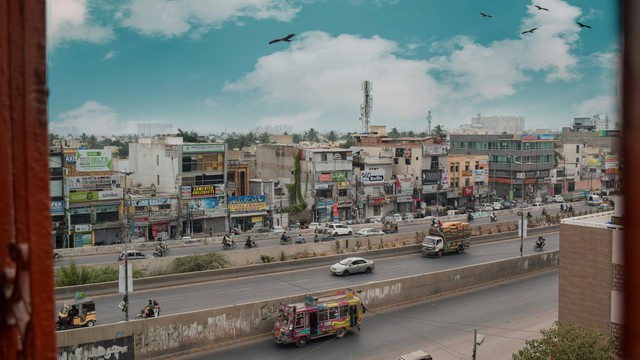World Toilet Day: People need equality and dignity when they 'have to go'
Wednesday, 19 November is the second World Toilet Day, organised by the United Nations. The 2014 theme is 'Equality and dignity'. Equality and dignity are challenged by the fact that across the world, 2.5 billion people lack access to basic (sometimes called 'improved') sanitation — generally defined as hygienic separation of people from faeces.


A community sanitation facility in Jinja, Uganda (Photo: David Dodman/IIED)
Yet, the World Health Organization estimates that improved sanitation brings economic benefits worth five times the investment (PDF), through factors including lowered healthcare costs and reduced absenteeism from work and school.
Inequality of toilet access
The quality of toilets in low-income urban areas varies, as does the type of organisation providing them. In Ugandan cities including Jinja (above), the National Slum Dwellers' Federation of Uganda has built community sanitation facilities in informal settlements (PDF).

A huge amount of work is needed to truly achieve global equality and dignity in access to basic sanitation.
Some of the most vulnerable groups are the disabled, who often have to deal with toilets that don't meet their needs, and women and children, who frequently face the threat of sexual violence when using public toilets.
There are significant inequalities in sanitation between groups.

It's still true that rural populations tend to have less access to improved sanitation than urban ones, but that's not always the case (as shown in the image).
And stark differences also remain within urban areas. In the informal settlements of Mombasa, Kenya, nearly 70 per cent of the wealthiest residents use flush toilets, while the figure for the poorest is less than 10 per cent (PDF)
Open defecation
About a billion people defecate in the open. Most of them live in middle-income countries, notably India. Every day, diseases transmitted through faeces kill around 6,000 people, 90 per cent of them children.

Defecating in the open also harms other aspects of wellbeing, from dignity to social development.
MDG7
Overall, the world is unlikely to meet the Millennium Development Goal 7, Target 7c, to "halve, by 2015, the proportion of the population without sustainable access to safe drinking water and basic sanitation".
Even if the target were claimed to be met, data gaps and measurement ambiguities would undermine its credibility. And insufficient ambition would raise questions about its validity.

Children and toilet access
The true costs of inadequate sanitation are higher than commonly perceived. Among children living in informal settlements, poor sanitation brings long-term impacts.
For example, diarrhoeal infections are linked with malnutrition, reduced schooling, impaired mental development, and many other factors that lessen life chances. Poor toilet facilities hold the next generation back.
Matching sanitation needs to solutions
One stumbling block in increasing sanitation access is that projects do not always match people's needs.

It is important to accommodate diversity within resident groups, such as disabled people (taken into account in the community toilet block shown in Jinja, Uganda) and the elderly.
It is equally important to consider factors such as privacy, security, cleanliness and maintenance, rather than seeing construction as the end of the story.
Sometimes a sanitation facility isn't well used. If that happens, policymakers and planners may assume residents aren't interested in improved sanitation. However, it may just be that the buildings are in fact inappropriate or inadequate.

Safety in toilet access
Toilets are often an unsafe place to 'go' even if they are behind a fence, as here in Omaruru, Namibia.
A practitioner's toolkit co-published by organisations including WaterAid identified four types of violence related to water, sanitation and hygiene: sexual violence, physical violence, psychological violence (such as harassment) and sociocultural violence (such as discrimination). It has been reported that increased monitoring of school toilets in South Africa has reduced attacks on girls.

Adressing the problem of toilet access
So what can be done? IIED and our long-term partner Shack/Slum Dwellers' International recently profiled work in Blantyre by the Malawi Federation of the Rural and Urban Poor. This emphasised the value of urban poor groups' relationships with local governments when it comes to improving sanitation and other services.
A participatory approach is crucial, and innovation at the neighbourhood and settlement levels is a promising path for change.
Residents of informal settlements and other city dwellers have shown how they can develop novel approaches to improved sanitation, including ecological sanitation technology in Zimbabwe (as shown), community toilet blocks in India, partnership-based management in Argentina, and small-scale entrepreneurship in a number of places.


In Karataka, an informal settlement near the airport in Dar es Salaam, Tanzania, people living in a shared compound have worked cooperatively to build a latrine.
And in places like Old Fadama, the largest informal settlement in Accra, Ghana, communities are assessing their own sanitation conditions and needs. A census-type survey here found that not a single household had its own private bathroom.
Sharing knowledge about urban sanitation
And we're doing our bit too, by connecting people working on urban sanitation and contributing to knowledge. IIED is a partner in SHARE — the Sanitation and Applied Hygiene Research for Equity programme, and runs SHARE's City-Wide Sanitation project together with Shack/Slum Dwellers' International, focusing on pro-poor sanitation in informal settlements.
In addition, the April 2015 issue of Environment and Urbanization, IIED's flagship journal, will look at sanitation and drainage in cities.
It will include articles relevant to this year's World Toilet Day theme, including a review of violence in the water, sanitation and hygiene sector; a study, arising from SHARE, of community inclusion in sanitation projects; and an analysis of sanitation as it affects adolescent girls in Indian urban settlements.
Christine Ro (christine.ro@iied.org) is the managing editor of Environment and Urbanization.



